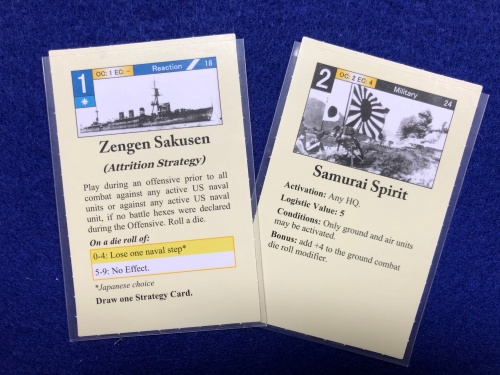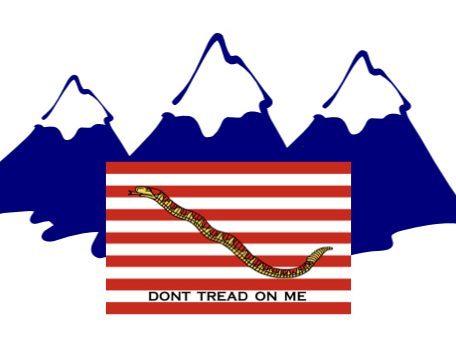MARK HERMAN’S PLAN ORANGE: PACIFIC WAR, 1932-1935 (C3i Magazine Nr. 29, 2016) is a challenging game. The challenge is not in the game design; mechanically the game is not that complex as it is another implementation of Mr. Herman’s (@markherman54) wonderful Card Driven Game (CDG) series. Nor is the challenge that it is a monster game; though derived from Empire of the Sun (GMT Games, 2005, 2015) it covers nearly the same area of conflict but in a much narrower focus. It’s that narrower focus that is the challenge, because if one goes into Plan Orange expecting to play Empire of the Sun you will get a rude awakening. This is because Mr. Herman has focused the game design of Plan Orange around Alfred Thayer Mahan.
Mr. Herman tells us what he is doing in the Player’s Notes to Plan Orange:
This is still the era of the battleship. Jutland was the battle of record and deeply studied in this period. So, while planes had firmly gained a role as long range reconnaissance and raiding elements in naval warfare, the arbiter of decision was still large caliber rifled guns carried by the battleships. What you will notice is the smaller zones of influence (ZOI) and combat power of the land based air reduces them to a supporting role in the war. This one factor makes Plan Orange a very different experience than Empire of the Sun.
 Doubling down on this difference, the victory conditions in Plan Orange emphasize the vision of the times that a naval conflict between the United States and Japan would be decided by a giant clash at sea. This really was the thinking of the day, especially for the Japanese as Sadao Asada explains in his book From Mahan to Pearl Harbor: The Imperial Japanese Navy and the United States (Annapolis, Naval Institute Press, 2006). When talking about the course of study at the Japanese Naval Staff College in the 1930’s, Mr. Asada points out:
Doubling down on this difference, the victory conditions in Plan Orange emphasize the vision of the times that a naval conflict between the United States and Japan would be decided by a giant clash at sea. This really was the thinking of the day, especially for the Japanese as Sadao Asada explains in his book From Mahan to Pearl Harbor: The Imperial Japanese Navy and the United States (Annapolis, Naval Institute Press, 2006). When talking about the course of study at the Japanese Naval Staff College in the 1930’s, Mr. Asada points out:
Student officers were schooled in the tradition of Mahan. Taking a leaf from Mahan’s Influence, their manual, the Kaisen yomurei, (Naval Battle Instructions) held that “war once declared must be waged offensively, aggressively.” Day in and day out they conducted war games against the American fleet that culminated in a decisive Mahanian engagement in the manner of Tsushima. In commencement exercises officers conducted war games in front of the emperor, simulating a magnificent main-fleet battle based on the principle of “big battleships and big guns.” Mesmerized by Mahan’s strategic doctrines, officers developed an obsession with the decisive fleet battle that would annihilate the enemy armada at one stroke. Their bible was the aforementioned Naval Battle Instructions, initially developed by Lieutenant Commander Akiyama Saneyuki at the Naval Staff College and sanctioned in 1910. Reflecting Mahan’s doctrine, it stated, “The battleship squadron is the main fleet, whose aim is to attack the enemy’s main fleet.” “The key to successful naval operations is initiative and concentration.” This manual, though revised five times, essentially remained intact until the mid-1930s. (Asado, p. 163)
In Plan Orange there are five ways to win, two of which are directly influenced by Mahan (but don’t be fooled, the others are too):
- Capital Ship Ratio: If at the end of Turn 4 (Jan-Apr 1933) or later, the US has 2 times or more battleship steps on the map than the Japanese have on the map, the US wins an Automatic Victory.
- Capital Ship Ratio: If at the end of Turn 4 or later, the Japanese have 1.5 times or more battleship steps on the map than the US, the Japanese win an Automatic Victory.
- Surrender: If Japan surrenders due to conquest of Honshu or blockade of the Home Islands the US player wins.
- Control the Philippines: If at the end of Turn 6 if either side controls all three Philippine surrender hexes, that player wins.
- Outlast the Americans: If at the end of Turn 6 no player has met any of the above conditions, the Japanese player wins.
I played Plan Orange twice this weekend. As I’m playing solo (and CDGs are not the best for solo play) I generally chose a ‘strategy’ for each side at the beginning and try to stick to it. For the Japanese I tried to follow Mr. Herman’s ‘Fabian strategy’ he mentions in the Player’s Notes where the Japanese conquers the Philippines, close out the US western bases, and set up defenses to delay the US advance. The Japanese need to hold onto the Philippines and take any opportunity they can to knock out the US Fleet Train when possible.
In the first game, for the US I tried to implement a quick ‘drive for home’ strategy focusing on hanging onto Midway and Wake, then trying to “strike for Japan’ via Marcus Island and Iwo Jima in order to impose a blockade. This didn’t work from the beginning in great part because I concentrated on bringing the US carriers in first. As a result, I had fewer battleships available and the Japanese hand was full of Zengen Sakusen (Attrition Strategy) cards which ended up taking away precious steps of battleships. This forced the US into a catch-up game and some degree of hesitancy as they were unwilling to risk the decisive battle without a clear battleship advantage. Although the US avoided a Japanese Automatic Victory they also failed to threaten the Philippines and never blockaded Japan. Clear Japanese victory.

I reset the game for another go. Keeping the same general Japanese strategy, this time I dedicated the Americans to a true central thrust through the Marianas to get to the Philippines. Battleships and troops were given priority. This strategy almost worked, and probably would have if not for a heroic stand by the Japanese Army at Manila/Corregidor. As luck would have it, the Japanese hand for Turn 6 included Samurai Spirit which is the only card that gives the Japanese any sort of real bonus in ground combat. It was enough to disrupt the final push on Manila. The Japanese won, but just barely.
I absolutely love the strategic tension the victory conditions create in Plan Orange. The American player must attack and try to retake the Philippines. If they don’t the Japanese win by default. The Japanese in turn will have to defend, but usually have to decide where and when is the right place to make a stand because in a war of attrition they cannot afford to lose too much. By the same token the Americans must attack but cannot be reckless lest they hand the victory to the Japanese. Although both sides want to preserve their fleet, they must risk their fleet for a win. All this in a relatively short two years, or six game turns.
Awesome game.
Feature image courtesy C3i Ops Magazine

A great game- played it once and it is on my must-revisit list post lockdown.
Cheers,
Pete.
Very interesting! The game seems to handle the strategic level very well.